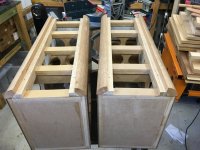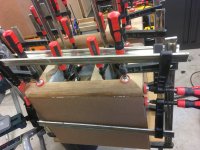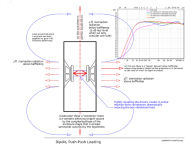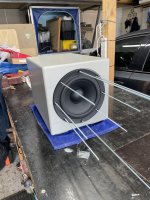Maybe something like this?In retrospect I might have been better off getting smaller but dual woofers so that they could oppose each other.
https://barefootsound.com/footprint02/
The 2" quarter round is not that common in hardware suppliers like Bunnings. I had to obtain from a specialist timber merchant and it may even require a special order. Hardwood is much preferred to softwood like pine, for painting/staining and especially since the edges will be more resistant to occasional knocks. Larger radius may be available but will be expensive.Very cool! Where can I get this product (or larger) here in Oz?
Yes, very much like that. Smart little beasts!Maybe something like this?
https://barefootsound.com/footprint02/
Though in my case it might be quite a lot easier to allow space around one side of the cabinet than it would be to clear both. So I'm content with my choice of one larger driver, really; being single-sided is just another small compromise to take consideration of.
Though for perspective, it is only larger in a relative sense. The SB23MFCL45 might have a chunky frame, but it is actually fairly small for a low woofer; it has an effective cone size of only about 6.5" diameter. That seems to be a characteristic of long-throw bass/sub type suspensions - they can take up more of the diameter. So in practice I wouldn't want to go massively smaller in frame size, even if there were two per side.
@Kev06
You may have spotted it from my first image in post #38, but I use exactly a pair of SB23MFCL45 in reaction-cancelling mode for the separate sub enclosure. The low Vas makes it suitable for a compact box, although with the magnet depth, about 280mm is the minimum box width to mount them back-to-back. I don't know if I would use a single SB23MFCL45 because any single driver sub I have used, "walks" under heavy drive. Another concern would be exciting resonance in the desk it sits on. This is a non-concern with reaction cancelling configuration.
I use 6.5" SB17NRX2C35 for the smaller near field monitor and it is flat down to 50 Hz at 1m on axis (post #8).
You may have spotted it from my first image in post #38, but I use exactly a pair of SB23MFCL45 in reaction-cancelling mode for the separate sub enclosure. The low Vas makes it suitable for a compact box, although with the magnet depth, about 280mm is the minimum box width to mount them back-to-back. I don't know if I would use a single SB23MFCL45 because any single driver sub I have used, "walks" under heavy drive. Another concern would be exciting resonance in the desk it sits on. This is a non-concern with reaction cancelling configuration.
I use 6.5" SB17NRX2C35 for the smaller near field monitor and it is flat down to 50 Hz at 1m on axis (post #8).
About awqard design. These looks fine if done nicely. Most of the pics are of diy versions. Very popular speaker in the 80ties. :
https://www.google.com/search?clien...HRTsBIIQ0pQJegQIChAB&biw=393&bih=719&dpr=2.75
Cheers!
https://www.google.com/search?clien...HRTsBIIQ0pQJegQIChAB&biw=393&bih=719&dpr=2.75
Cheers!
Maybe Planet10 can explain it better than me.I still don't get it.
https://www.diyaudio.com/community/...er-w-pd-21-drivers.402264/page-5#post-7433034
By the way, the in-phase config is called bipole not dipole as I have been calling it. Borrowing from Planet10's post.
Attachments
Hi,
Like STV i'm sceptic about Dave's explanation. Don't take me wrong, i experimented with push/push thanks to him and i'm convinced by the outcome but simulation doesn't track his explanation ( or i don't get them):
https://www.diyaudio.com/community/threads/tachi-coaxial-point-source-bem-modelling.386711/
Bon, very nice speakers! You find them better than the impressive built you've done some years ago ( with CLD, decoupling of bass drivers and faceted box for mid/high)?
Like STV i'm sceptic about Dave's explanation. Don't take me wrong, i experimented with push/push thanks to him and i'm convinced by the outcome but simulation doesn't track his explanation ( or i don't get them):
https://www.diyaudio.com/community/threads/tachi-coaxial-point-source-bem-modelling.386711/
Bon, very nice speakers! You find them better than the impressive built you've done some years ago ( with CLD, decoupling of bass drivers and faceted box for mid/high)?
I'd gone down a deeper rabbit hole than that, but yes I'm still potentially looking at a trapezoid or angled front baffle. It partly depends on what drivers I settle on and whether I want to toe those in or not.About awqard design. These looks fine if done nicely. Most of the pics are of diy versions. Very popular speaker in the 80ties. :
https://www.google.com/search?clien...HRTsBIIQ0pQJegQIChAB&biw=393&bih=719&dpr=2.75
Cheers!
Thanks Bon!Borrowing from Planet10's post.
Now i see what seems to be our "disagreement".
You were speaking about "cancellation" while in planet10's graph there is only a dip of max 4 dB in response depending on the placement of the box near a wall.
After some thought, I suspect there may be a way to 'partially' cheat the dual opposing/force-cancelling thing in my situation, even with single woofers per side. I reasoned that:

(monitor shown as if translucent, above, to help illustrate)

Looking at the top drawing (front view) it wouldn't take much to couple the two opposing woofer cabinets, either directly or through a shared stand.
Admittedly, my third assumption might be a bit shaky; I think most realistically recorded music will follow along with the lack of directivity that low frequencies posses, and so reproduce them in common on both left and right channels. Electronic and highly produced types may not, necessarily, but obviously a great many speakers have just a single big woofer and it isn't the end of the world. These things are only small in my case, so if they want to move I'll just screw them to a rigid stand or bracket.
- The woofer cabinets are quite close together, within the width of a desk,
- I'm already intending the drivers to be side-firing, and facing in opposite directions,
- In many cases the lowest frequencies (where excursion is greatest) will likely be common to both stereo channels.
(monitor shown as if translucent, above, to help illustrate)
Looking at the top drawing (front view) it wouldn't take much to couple the two opposing woofer cabinets, either directly or through a shared stand.
Admittedly, my third assumption might be a bit shaky; I think most realistically recorded music will follow along with the lack of directivity that low frequencies posses, and so reproduce them in common on both left and right channels. Electronic and highly produced types may not, necessarily, but obviously a great many speakers have just a single big woofer and it isn't the end of the world. These things are only small in my case, so if they want to move I'll just screw them to a rigid stand or bracket.
Last edited:
My motivation for the original MTM+side woofers, was the need for a compact near-field monitor with adequate bass.Like STV i'm sceptic about Dave's explanation. Don't take me wrong, i experimented with push/push thanks to him and i'm convinced by the outcome but simulation doesn't track his explanation ( or i don't get them):
https://www.diyaudio.com/community/threads/tachi-coaxial-point-source-bem-modelling.386711/
Since listening was always supposed to be on the tweeter axis, I didn't overly fuss about off-axis response. However after the build and set-up, I noticed whenever I was at either side of a speaker, the bass fell right away, on music and with pink noise. After giving it some consideration, I came up with the same reasoning as planet10. The acoustic output of the push-push woofers is in phase on the tweeter axis, but out-of-phase on the woofer axis. I experimented by removing one woofer and the bass was essentially omni-directional. (BTW just disconnecting one woofer is not enough because the back-pressure of the active woofer moves the cone of the disconnected woofer out-of-phase, which messes up the experiment).
Since a polar magnitude plot of each woofer separately should be nearly identical at bass frequencies, the cancellation must be due to phase difference.
Since the CLD build (2012) I have been scaling down the size of the enclosures to try and attain similar results as when size is not a consideration. I prefer the force cancelling approach, together with bracing, for control of enclosure excitation, nowadays.Bon, very nice speakers! You find them better than the impressive built you've done some years ago ( with CLD, decoupling of bass drivers and faceted box for mid/high)?
The side-mounted woofers definitely drives the room acoustic differently than front mounted.
Force cancelling requires both drivers to share the same enclosure and have identical signal. It was common practice to "mono" low bass in the pre-digital era. A single mono bass enclosure would work. I have built many force cancelling subs like this.This is one type of configuration I was already considering, which would particularly lend itself to the idea:
- In many cases the lowest frequencies (where excursion is greatest) will likely be common to both stereo channels.
View attachment 1205526
(monitor shown as if translucent, above, to help illustrate)
So you would need to L+R your bass signal.
In the image below, the driver frames are connected by tensioned threaded rod.
Attachments
I wonder if some spl cancelation occurs between the two cabinets in the axis of the listener, because of two wwoffers looking at each others and playing the same materialfirering in phase opposition ? Should this frequency cancellation occurs at the wave length given by the cabinets spacing ? ... or is it ok and stilll 4 Pi so that doesn't matter ?
off topic : the barefoot micro 26 looks very nice but I wonder about th MTM layout while it's 1.5 filter that is applied to the two 5.25 mid and at the same time playing relativly high (3 k khz) with such layout (honeycomb filtering behavior of the MTM when going high towards the treble range due to the spacing (center to center of the two drivers being far because of the in between tweeter). Anyway we see that the acoustic cut off is about 100 hz with the side woofers (which is meaning maybe a little higher electrical cut off I assume?).
off topic : the barefoot micro 26 looks very nice but I wonder about th MTM layout while it's 1.5 filter that is applied to the two 5.25 mid and at the same time playing relativly high (3 k khz) with such layout (honeycomb filtering behavior of the MTM when going high towards the treble range due to the spacing (center to center of the two drivers being far because of the in between tweeter). Anyway we see that the acoustic cut off is about 100 hz with the side woofers (which is meaning maybe a little higher electrical cut off I assume?).
Last edited:
Bon, the same signal is certainly true; my expectation is that many recordings might do this (to at least a useful degree) for lowest fequencies even if not formally made mono. Though I may well be wrong.
TBH I'm not 'massively' bothered if not, though. At the modest SPLs and driver size involved in my little application, it probably isn't the most pressing requirement within the bundle of compromises to be made. Compared to (e.g) having second drivers firing into small, boomy spaces. When a decently rigid bracket or stand would certainly work here. I do have a pretty weighty desk to serve as an anchor, or there might even be the masonry wall that it is located against.
I would think very differently if i were trying to make something like larger, higher spl and free-standing speakers, of course.
TBH I'm not 'massively' bothered if not, though. At the modest SPLs and driver size involved in my little application, it probably isn't the most pressing requirement within the bundle of compromises to be made. Compared to (e.g) having second drivers firing into small, boomy spaces. When a decently rigid bracket or stand would certainly work here. I do have a pretty weighty desk to serve as an anchor, or there might even be the masonry wall that it is located against.
I would think very differently if i were trying to make something like larger, higher spl and free-standing speakers, of course.
Ok, STV got it, the little graph up right and Dave talking about bsc made it clearer to me, it's related to the highest freq usable with this config and location in room ( SBIR related notch).
Like i mentioned in thread linked i won't use this config higher than 200/300hz ( driver diameter -more precisely their depth- related ). I have something loosely inspired by Dave's Tysen v2 with a pair of 6'5" as force cancelling and the usable upper freq is circa 300hz, they are xover one octave lower at 24db/octave to a fullrange in sealed box. It mitigate issues as all drivers are well within 1/4 wavelength spacing ( so overall omni) and baffle width of 20cm makes the xover freq below the full bsc compensation ( iow at 150hz there is omni radiation for all drivers and no box shadowing effects anymore).
The issue Dave mention about loudspeaker's backwall ( frontwall when facing loudspeakers) is related to usable highest freq range too: too high and you have notch mentioned in Dave's explanation but if you cut lower it can play with you:
Last summer i experimented with 12" car sub in same config and figured the highest limit was circa 200hz ( with the driver and box i prototyped, it might be different with another one, idk?). In that case i would have x them no higher than circa 100hz with 4pole filter, maybe a bit higher with 8pole FIR xover but not much, and in that case would have made divers close to floor and backwall to gain +6db from boundary loading ( a plus for me as it lower requirements of eq ( or compromise on max SPL from required eq) as i almost always use Linkwitz Transform/sealed in small volume box to lower usable freq range and low final Qtc - 0,577).
Not really different from Roy F. Allisson approach.
The compromise being now in the midrange ( if the box is used as stand as in Bon's latest loudspeakers) as they'll suffer from close proximity of boundary ( loudspeaker's backwall/ listener's facing one). Answer being sattelite approach or directivity management for mids/high freq ( either by waveguide, meh or cardio ala D&D).
Compromise, compromise,... always compromise. The point being to find the right set for your goal.
I'm not sure the room loading is different in the lows wrt a single driver. At least it didn't show up with the test i made.
In the mid ( from 250hz up) the simulations i linked previously show clearly what happen and there yes i agree room loading is different.
Bon, did you documented your latest build ( otherwise that the pictures you shared here)? I learned so much from your 2012 ( epic!) effort!
Like i mentioned in thread linked i won't use this config higher than 200/300hz ( driver diameter -more precisely their depth- related ). I have something loosely inspired by Dave's Tysen v2 with a pair of 6'5" as force cancelling and the usable upper freq is circa 300hz, they are xover one octave lower at 24db/octave to a fullrange in sealed box. It mitigate issues as all drivers are well within 1/4 wavelength spacing ( so overall omni) and baffle width of 20cm makes the xover freq below the full bsc compensation ( iow at 150hz there is omni radiation for all drivers and no box shadowing effects anymore).
The issue Dave mention about loudspeaker's backwall ( frontwall when facing loudspeakers) is related to usable highest freq range too: too high and you have notch mentioned in Dave's explanation but if you cut lower it can play with you:
Last summer i experimented with 12" car sub in same config and figured the highest limit was circa 200hz ( with the driver and box i prototyped, it might be different with another one, idk?). In that case i would have x them no higher than circa 100hz with 4pole filter, maybe a bit higher with 8pole FIR xover but not much, and in that case would have made divers close to floor and backwall to gain +6db from boundary loading ( a plus for me as it lower requirements of eq ( or compromise on max SPL from required eq) as i almost always use Linkwitz Transform/sealed in small volume box to lower usable freq range and low final Qtc - 0,577).
Not really different from Roy F. Allisson approach.
The compromise being now in the midrange ( if the box is used as stand as in Bon's latest loudspeakers) as they'll suffer from close proximity of boundary ( loudspeaker's backwall/ listener's facing one). Answer being sattelite approach or directivity management for mids/high freq ( either by waveguide, meh or cardio ala D&D).
Compromise, compromise,... always compromise. The point being to find the right set for your goal.
I'm not sure the room loading is different in the lows wrt a single driver. At least it didn't show up with the test i made.
In the mid ( from 250hz up) the simulations i linked previously show clearly what happen and there yes i agree room loading is different.
Bon, did you documented your latest build ( otherwise that the pictures you shared here)? I learned so much from your 2012 ( epic!) effort!
@krivium
Yes, I have a photo diary of my build. To not hijack this thread, I may post a build report in a new thread.
The common concept with this thread, is force-cancelling woofers. I have been influenced by ideas from the AR9, NHT 3.3 and various vintage Allison Acoustics models.
I appreciate the kind words about my earlier build. It attempted to deal with most of the issues I gave a high priority back then (and still now).
However time moves on and technology presents other solutions. Curiosity prevails, and I just have to know if I can do better with my skill set, facilities and budget.
Yes, I have a photo diary of my build. To not hijack this thread, I may post a build report in a new thread.
The common concept with this thread, is force-cancelling woofers. I have been influenced by ideas from the AR9, NHT 3.3 and various vintage Allison Acoustics models.
I appreciate the kind words about my earlier build. It attempted to deal with most of the issues I gave a high priority back then (and still now).
However time moves on and technology presents other solutions. Curiosity prevails, and I just have to know if I can do better with my skill set, facilities and budget.
Yes, the thread has diverged from the original topic, as these things tend to (e.g. force cancelling wasn't part of the question). The discussions concerning radiation patterns, frequencies and driver spacing have all been quite relevant though, so it has still managed to be a very helpful thread. Thanks to all who have contributed!
I can progress now, so will probably start a new thread once I begin the design and build stages. So I don't mind at all if people want to continue discussing whatever they wish on this one. Though some of what has been said lately is possibly counterintuitive and/or possibly talking at cross-purposes, so I agree that maybe a thread dedicated to the subject might be clearer.
Cheers, Kev
I can progress now, so will probably start a new thread once I begin the design and build stages. So I don't mind at all if people want to continue discussing whatever they wish on this one. Though some of what has been said lately is possibly counterintuitive and/or possibly talking at cross-purposes, so I agree that maybe a thread dedicated to the subject might be clearer.
Cheers, Kev
- Home
- Loudspeakers
- Multi-Way
- Side-firing woofers and crossover frequency in the near-field




